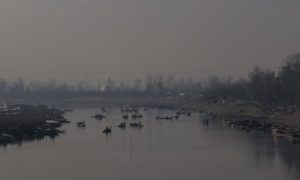Kupwara: The springs and other water resources in Lolab, also known as Lolab Valley, in north Kashmir’s Kupwara district, are getting polluted, with authorities paying no heed to it.
Lolab Valley has many springs which are traversed by a stream known as Lalkul (Lahwal). The water to Lalkul is contributed by numerous tributaries flowing from surrounding hills which are closed by the dense forests of Deodar. It is a splendour and perennial water resource.
This river adds to the beauty of the valley under the shining sun in the endless nature’s bounty in every direction.
The people of Lolab believe the water of Lalkul cures ailments, especially skin-related diseases. “Many people still come here to bath in this healing water,” a local said.
Also, owing to its incomparable value, the stream is pure ecstasy for travellers, providing a mesmerizing view. Once visiting the stream, the people keep coming here owing to its unmatched elegance, Sultan said.
Other springs including Lavnag, Satisar, Gaurinag, Pirnag and Sogamnag are other major springs in Lolab. “The Lavnag spring is three-feet-long and used to have such pure, clean and crystal water years ago that one could see a mirror image in it,” another local Mir Jaffer said. “It presents a spectacular view.”
A resident of Lolab, Peer Rafiq, said, “These springs have their own value and a history behind them, which goes back to the legend of the Satisar period – a former lake in the Kashmir Valley meaning ‘the lake of the Goddess Sati’. Hence these were kept in high regard by the local population because of their sacred nature and medicinal value. The Satisar spring is very sacred and has connections to Sufi saints.”
The spring is integral to tourism and recreation in the Lolab Valley. Both Lavnag and Satisar are located in the Sogam area.
The locals said they use the water of these springs for drinking and washing. “Although the stagnant water is dotted with leaves, insects, garbage and polythene, these springs have now become seasonal and some have vanished completely,” an elderly person Mohammad Sultan said. “Due to the mixing of inorganic fertilizers and residential sewage from the nearby catchment regions, some springs were found acidic.”
The people of Lolab believe that spring water is a divine blessing and a good sign. “Majority of the people here are uneducated. Women use this water for domestic purposes, but it is not a cakewalk to make them understand the conservation and management of water resources. The administration must step in and protect these springs,” Zahid Lone, a student, said.
“Once the administration steps in, the impact of human activities on these springs will be reduced and the water will be still suitable for drinking and we don’t need to rely on any other water source,” Farooq Ahmad, a shopkeeper at Goose, Kupwara, said. (KNO)








